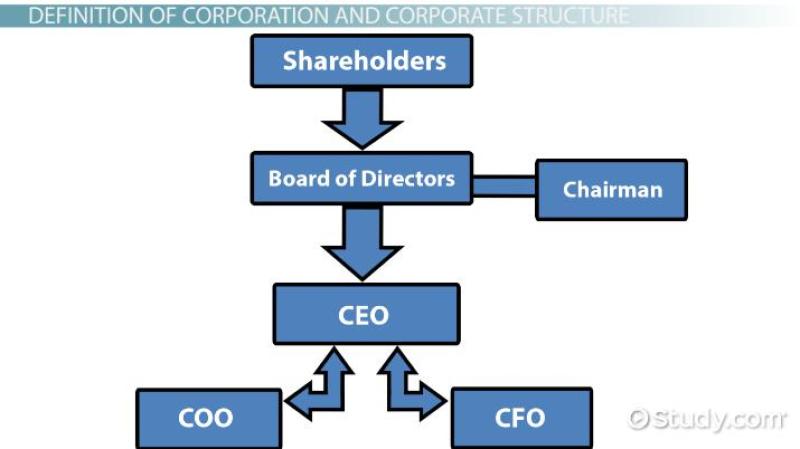What is the management structure of a corporation?
The management structure of a corporation refers to the organization of roles, responsibilities, and relationships among individuals within the company. This structure is designed to facilitate efficient decision-making, coordination of activities, and overall governance of the business. The specific details of a corporate management structure can vary based on the size of the company, industry, and its unique needs, but there are common elements in most corporations. Here's an overview of the key components:
Board of Directors:
- Role: The board of directors is typically the highest governing body in a corporation. Directors are elected by shareholders and are responsible for overseeing the company's overall direction and performance.
- Responsibilities: Setting company policies, appointing executives, approving major decisions, and representing shareholders' interests.
Chief Executive Officer (CEO):
- Role: The CEO is the top executive in the company and is responsible for the overall strategic direction and day-to-day operations.
- Responsibilities: Making major corporate decisions, managing relationships with stakeholders, setting the company's vision and strategy, and overseeing the executive team.
Executive Team (C-Suite):
- Composition: This includes top-level executives with titles such as Chief Financial Officer (CFO), Chief Operating Officer (COO), Chief Information Officer (CIO), Chief Marketing Officer (CMO), and others.
- Role: Each executive is responsible for a specific functional area, such as finance, operations, technology, or marketing.
- Responsibilities: Implementing the CEO's strategic vision, managing their respective departments, and contributing to overall company success.
Middle Management:
- Composition: This tier includes managers and directors overseeing specific departments or divisions.
- Role: Implementing the strategies set by the executive team, managing day-to-day operations, and ensuring the efficient functioning of their respective areas.
Employees:
- Role: These are the individuals who carry out the tasks and responsibilities assigned to them by middle management. They form the backbone of the organization and contribute to its daily operations.
Shareholders:
- Role: Shareholders are the owners of the corporation. They elect the board of directors and may have the right to vote on certain matters affecting the company.
- Responsibilities: Voting on key issues (such as board elections) and potentially receiving dividends or benefiting from the company's stock value appreciation.
It's important to note that the actual titles and roles can vary, and some companies may have additional layers of management or unique structures. Additionally, the trend toward flatter organizational structures and a greater emphasis on collaboration and flexibility has led some companies to adopt more unconventional management approaches.
Organizational hierarchy: What is the management structure of a corporation?
The management structure of a corporation is the hierarchy of managers who oversee the company's operations. It defines the lines of authority and responsibility within the company.
The typical management structure of a corporation has three levels:
- Upper management: This level includes the CEO, CFO, COO, and other senior executives. Upper management is responsible for setting the company's overall strategy and direction.
- Middle management: This level includes department managers and other mid-level executives. Middle management is responsible for implementing upper management's strategy and direction at the departmental level.
- Lower management: This level includes supervisors and other front-line managers. Lower management is responsible for overseeing the day-to-day operations of the company.
Examining the levels and roles within the management structure of a typical corporation
Upper management
- CEO (Chief Executive Officer): The CEO is the highest-ranking executive in a corporation. The CEO is responsible for the overall performance of the company and reports directly to the board of directors.
- CFO (Chief Financial Officer): The CFO is responsible for the financial management of the company. The CFO oversees the company's accounting, budgeting, and financial planning.
- COO (Chief Operating Officer): The COO is responsible for the day-to-day operations of the company. The COO oversees the company's production, marketing, and sales functions.
Middle management
- Department managers: Department managers are responsible for overseeing the operations of a specific department within the company. For example, a company may have a marketing department manager, a sales department manager, and a production department manager.
- Mid-level executives: Mid-level executives are typically responsible for a specific function within the company, such as accounting, human resources, or information technology.
Lower management
- Supervisors: Supervisors oversee the work of front-line employees. They are responsible for assigning tasks, providing training, and monitoring employee performance.
- Front-line managers: Front-line managers are the lowest-ranking level of management in a corporation. They are responsible for the day-to-day operations of a specific work unit, such as a production line or a retail store.
Tips for understanding and navigating the corporate hierarchy
Here are some tips for understanding and navigating the corporate hierarchy:
- Know your place in the hierarchy. Understand your level of authority and responsibility within the company.
- Understand the lines of communication. Know who your direct supervisor is and who you should report to for specific issues.
- Build relationships with your managers. Get to know your managers and their goals. This will help you to better understand the company's overall strategy and direction.
- Be proactive. Don't wait for your managers to come to you with assignments. Take initiative and ask for more responsibility.
- Be respectful of everyone in the hierarchy. Remember that everyone has a role to play in the company's success.
By understanding and navigating the corporate hierarchy, you can position yourself for success in your career.










